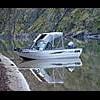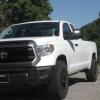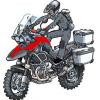In one week from today my wife and I will be driving to Boise to receive our Hawk shell. We have been waiting for a year for this and the stoke factor is high. We have gone through many iterations on how we explore the west. Starting with a 06 GMC Sierra w/ a Leer Hi-top topper, to a 14 Tundra ( hit an elk w/ the GMC) with a 06 Coleman Cobalt popup trailer (on 12'' tires, super fun setup), to a ridiculously over built DIY truck topper... And now, the current holy grail, 22 Hawk shell w/ side dinette.
My goal for this new platform is to try and build the most practical, capable, lightweight, setups I can to get us farther into public land. What I mean by that is, the West is getting a bit busy with all the Wandering people are doing right now. Thats great, I'm stoked people are getting out, that doesn't mean I want to camp with them.
Anyways, back to the build... 2014 Tundra 120,xxx miles DC, 6'7'' bed on 33''s w/ Bilsteen stuts, leveling kit and soon to be installed custom leaf package from Boise Spring Works. We don't have any kids right now, and except for our special needs dog "Carl" we try and travel light. When starting to narrow down what we actually wanted in a camper, staying as close to or below the GVWR of the tundra was my number 1. Tundras are great at towing but lack in the payload dept. Mine can handle right around 1475 lbs in the bed. So right away that narrowed the field, and long story short we ended up on Four Wheel campers. A Kimbo or Scout would have been great but I think they are too big and heavy to get into the nooks of the west we seek. Prior to ending up with the Hawk shell we strongly debated on the Flatbed version and going with some AU brand of Ute tray, but after looking deep into this at the end of the day, no matter what suspension upgrades you do, you'r still over GVWR. I read somewhere that Tundras had some special type of wheel bearing that inhibit this vehicles ability to carry more weight, and also Toyota does not give their blessing at all to pulling off the stock bed and swapping with a flatbed. Can anyone confirm this?
We went with the shell because I wanted a simple blank slate in which to outfit it to our specific needs and desires in a camper. We didn't want all the add ons, just the ones that made sense to us. I am a carpenter and have my own remodeling business in the local are we live in, so I'm handy when it comes to DIY. Im not saying Im the best at this, but building and making things from scratch is definitely in my wheelhouse.
I wanted to share this build in hopes to give people ideas in their future builds. I am a long time researcher of the Expedition Portal world and have gained a lot of knowledge from other peoples posts, but since WTW seems to be more hard sided pop up oriented I decided to post here in hopes to give and get further inspiration and knowledge where i think it will be better received.
I am also on IG under the handle @seedwoodworking I will try and post more photos and videos on the build process. Please by all means, chime in and let me know if there is an easier or better way of doing something. My goal is to learn.
Take a look in my gallery for the previous setups. Gallery
Enjoy!
Edited by ST85, 03 February 2022 - 06:08 PM.


















